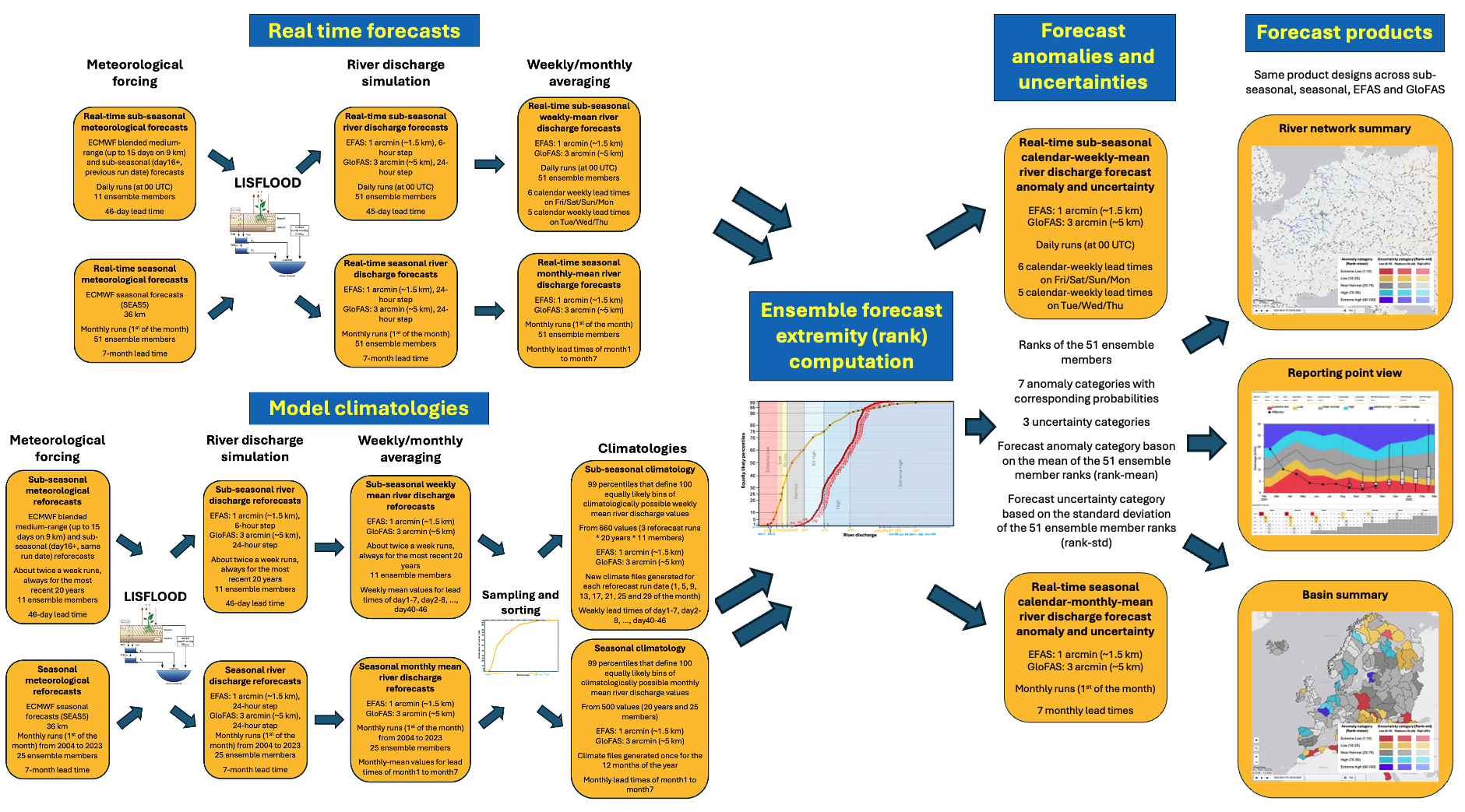...
| Expand | ||
|---|---|---|
| ||
Suggestion to move the method description of earlier seasonal and sub-seasonal here To be completed |
...
What is new?
CEMS-Flood sub-seasonal products are produced every day, showing calendar week river discharge anomalies up to 7 weeks divided into 5 categories, from extreme low to extreme high compared with a forecast-range dependant climatology
CEMS-Flood seasonal products are produced every month, showing monthly river discharge anomalies up to 7 months divided into 5 categories, from extreme low to extreme high compared with a forecast-range dependant climatology
Both sub-seasonal and seasonal products are available for the EFAS and GloFAS systems, and shown as maps over the full domain and additional information on reporting points.
Rationale and overview
In a sub-seasonal or seasonal forecast, especially at the the longer ranges, the day-to-day variability of the river flow, with prediction of the actual expected flood severities, can not be expected due to the very high uncertainties. What is possible, is to rather give an indication of the river discharge anomalies and the confidence in those predicted anomalies. As the forecast range increases, the uncertainty will also generally increase and with it the sharpness of the forecasts will gradually decrease and they will more and more replicate the climatologically expected conditions with some possible positive or negative shift (i.e. anomaly). The generation of the sub-seasonal and seasonal forecast signals and the related products is reflective of this and was designed to deliver a simple to understand categorical information for both the anomalies and the related associated uncertainties present in the forecast, very much relative to the underlying climatological distribution.
Workflow
The generation of the sub-seasonal and seasonal forecast signal relies on few major steps . The process is illustrated by a flowchart in Figure 1. The forecast anomaly and uncertainty signals is derived by comparing the real time forecast (top left section in Figure 1) to the 99-value percentile climatology. The climatology is generated using reforecasts over a 20-year period, which provides range-dependent climate percentiles that change with the lead time. The climate generation is described in the bottom right corner of Figure 1.
...
Figure 1. Flowchart of the sub-seasonal and seasonal anomaly and uncertainty signal generation methodology.
...
| title | Want to know more? |
|---|
.
The CEMS-Flood sub-seasonal products cover calendar week periods (i.e. always Monday-Sunday), while the CEMS-Flood seasonal products are valid for whole calendar month periods. The forecast signal is derived from the relationship between the calendar weekly or monthly averaged river discharge and the climatological distribution of the same weekly- or monthly-averaged values. While this naturally works for the calendar months, the fixed calendar weekly lead times in the sub-seasonal allow the users to directly compare forecasts from different forecast runs, as the verification period is fixed onto the calendar weeks. This way, the evolution of the subsequent daily sub-seasonal forecast runs (always at 00 UTC) can be monitored by looking at the exact same verification period.
| Tip | ||
|---|---|---|
| ||
Further details of the real time forecasts, reforecasts and the generation of the climatologies are available here: Placeholder Description of the real time forecasts, reforecasts and climatologies as components of the CEMS-flood sub-seasonal and seasonal forecasts. |
Definition of anomaly and uncertainty signal
The anomaly and uncertainty signals are determined by comparing the real time forecast ensemble members to the model climatology (see the middle-right section in Figure 1). This identifies, how extreme those ensemble members of the forecast are in the context of the climatological behaviour, which is represented by the 99 percentiles and the corresponding 100 equally likely bins of the climatological range. Each ensemble member gets a rank from 1 to 100, after sorting them into one of the 100 climatological bins. The real time ensemble forecast then will have 51 rank values from 1 to 100.
...
Moreover, the overall anomaly of the forecast is defined by the mean of the 51 ensemble member ranks (Rank-mean), which will represent a robust anomaly value without any random jumpiness. In addition, the uncertainty about these anomalies is also defined by the 51 ensemble ranks, namely by their standard deviation (Rank-std). Based on this rank standard deviation value, one of three uncertainty categories (low / medium / high) will be assigned to the forecast. Further information on the computation methodology of the forecast anomaly and uncertainty signals is available here: Placeholder CEMS-flood sub-seasonal and seasonal forecast anomaly and uncertainty computation methodology.
Product overview
Regarding the sub-seasonal and seasonal products, two web layers are available on the EFAS and GloFAS websites. These are the the river network summary map, which also includes the reporting points and the related popup windows delivering extra information about the forecast evolution, and the basin summary map (see the last column on the right of Figure 1).
...
